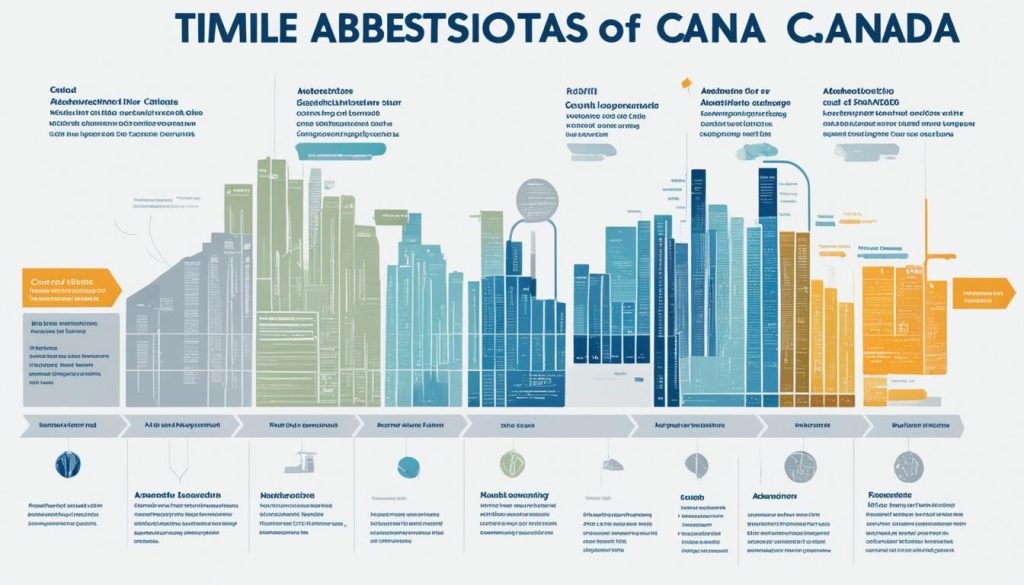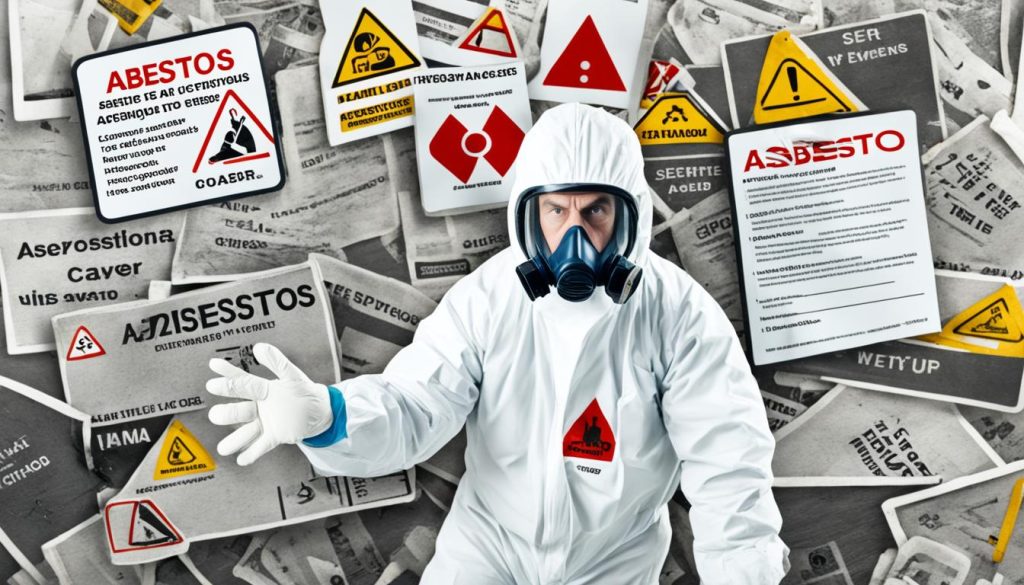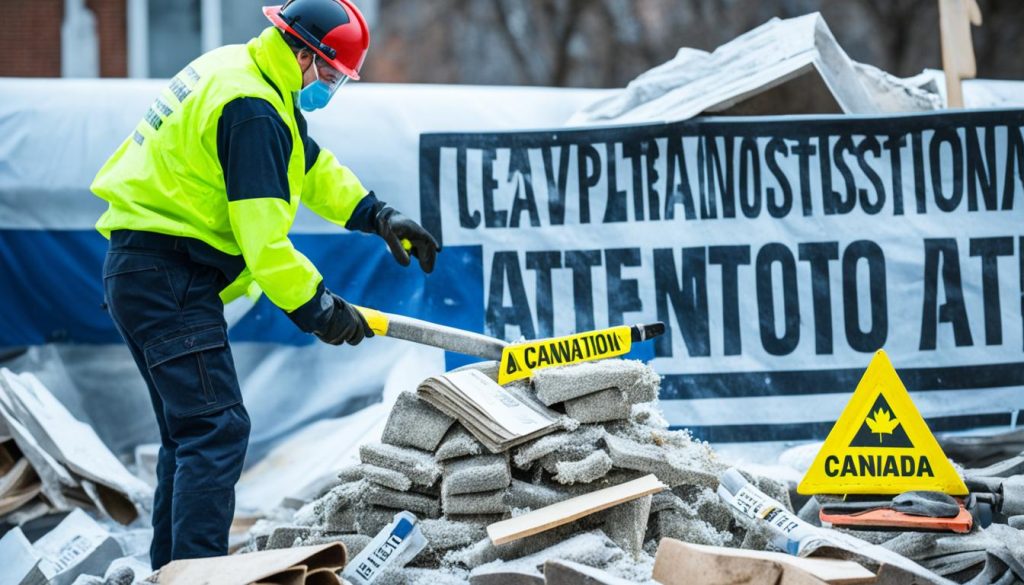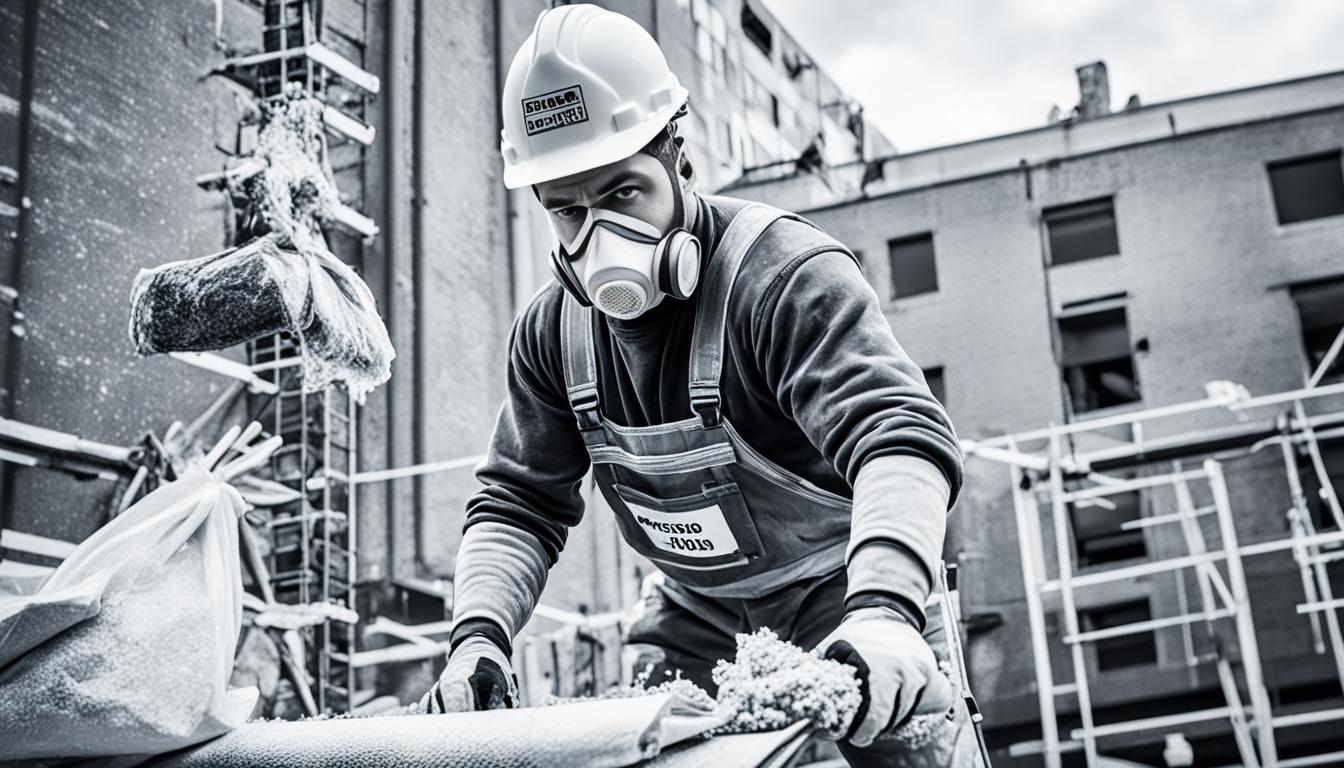Did you know that Canada was once a global leader in asbestos production, with several mines operating across the country? However, the tides have turned, and Canada now stands at the forefront of the fight against this hazardous mineral. In a significant move, the Canadian government announced a ban on the manufacture, import, sale, and use of asbestos and products containing asbestos, which came into effect on December 30, 2018.
This comprehensive guide will take you on a journey through the fascinating history of asbestos in Canada, the timeline of asbestos regulations and the phase-out process, as well as the health risks associated with asbestos exposure. We’ll also explore the presence of asbestos in building materials and automotive parts, and provide practical steps to reduce exposure. Finally, we’ll delve into Canada’s asbestos legacy and the country’s ongoing efforts to protect its citizens from this persistent threat.
Introduction to Asbestos and Its History in Canada
Asbestos is a naturally occurring mineral that was once widely used in manufacturing and construction due to its heat-resistant and strengthening properties. Before the 1990s, asbestos was mainly used for insulating buildings and homes against cold weather, noise, and for fireproofing. Canada was once a world leader in asbestos production, with several mines operating in the country. However, the use of asbestos has declined significantly in recent decades as the public became more aware of its health dangers.
What is Asbestos?
Asbestos is a group of naturally occurring, fibrous silicate minerals that have been used in a variety of applications due to their durability, heat resistance, and insulating properties. These unique characteristics made asbestos a popular choice for construction materials, automotive parts, and various industrial processes. The widespread use of asbestos in Canada during the 20th century has left a lasting impact on the country’s history and the health of its citizens.
Canada’s Asbestos Industry: A Brief Overview
Canada was once a global leader in the production and export of asbestos, with major mining operations located in the province of Quebec. The country’s asbestos industry played a significant role in its economy, providing employment and generating significant revenue. However, as the health risks associated with asbestos exposure became better understood, the Canadian government and public opinion began to shift, leading to a gradual decline in the use of asbestos and the eventual ban on its manufacture, import, sale, and use in 2018.
When Was Asbestos Banned in Canada?
The Canadian government announced a ban on the manufacture, import, sale, and use of asbestos and products containing asbestos, which came into effect on December 30, 2018. This ban, known as the Prohibition of Asbestos and Products Containing Asbestos Regulations, was the final step in the country’s efforts to phase out the use of asbestos and protect Canadians from the health risks associated with asbestos exposure.
The asbestos ban in Canada followed a long history of the country’s involvement in the asbestos industry. Canada was once a world leader in asbestos production, with several mines operating within its borders. However, as public awareness of the health dangers of asbestos grew, the use of this mineral declined significantly in recent decades.
The timeline of asbestos regulations in Canada includes various measures taken by the government to limit the use and exposure to asbestos, leading up to the final ban on asbestos and asbestos-containing products. This comprehensive asbestos restriction in Canada represents a significant milestone in the country’s efforts to address its asbestos legacy and ensure a healthier future for all Canadians.

Asbestos Regulations and Prohibitions in Canada
Canada has taken significant steps to address the risks associated with asbestos exposure by implementing comprehensive regulations and prohibitions. The cornerstone of these efforts is the Prohibition of Asbestos and Products Containing Asbestos Regulations, which came into effect on December 30, 2018.
The Prohibition of Asbestos and Products Containing Asbestos Regulations
The Prohibition of Asbestos and Products Containing Asbestos Regulations in Canada ban the import, manufacture, sale, and use of asbestos and asbestos-containing products. This regulation represents a crucial milestone in the country’s efforts to protect its citizens from the harmful effects of asbestos exposure.
Exemptions to the Asbestos Ban
While the asbestos ban is comprehensive, the regulations do include a few limited exemptions. These exemptions allow the use of asbestos in specific industries and applications, such as the chlor-alkali industry, military and nuclear facilities, and for magnesium extraction from asbestos mining residue. Additionally, the regulations include increased safety regulations for workers in the chlor-alkali sector and provide for the possibility of special permits to use asbestos products if there are no technically or economically feasible alternatives.
The implementation of the Prohibition of Asbestos and Products Containing Asbestos Regulations in Canada represents a significant step forward in the country’s efforts to address the asbestos regulations in canada, canadian asbestos laws, asbestos prohibition canada, asbestos regulations canada, and asbestos policy canada. By banning the import, manufacture, sale, and use of asbestos and asbestos-containing products, Canada is working to protect its citizens from the health risks associated with asbestos exposure.
Health Risks Associated with Asbestos Exposure
Asbestos exposure can have severe consequences for one’s health, leading to a range of serious medical conditions. Among the primary health risks associated with asbestos exposure are lung cancer, asbestosis, and mesothelioma.
Lung Cancer
Exposure to asbestos fibers has been directly linked to an increased risk of developing lung cancer. Inhaling these microscopic fibers can cause cellular damage and mutations, ultimately leading to the formation of cancerous tumors in the lungs. Individuals who have a history of asbestos exposure, especially those who also smoke, face a significantly higher risk of lung cancer.
Asbestosis
Asbestosis is a chronic, progressive lung disease caused by the inhalation of asbestos fibers. These fibers become lodged in the lungs, causing inflammation and scarring, which can impair breathing and lead to respiratory distress. The first signs of asbestosis may include shortness of breath, coughing, and chest pain, which can worsen over time as the condition progresses.
Mesothelioma
Mesothelioma is a rare and aggressive form of cancer that affects the lining of the chest or abdominal cavity, known as the mesothelium. It is almost exclusively caused by exposure to asbestos fibers, and the latency period between exposure and the development of mesothelioma can be several decades. Mesothelioma is a particularly challenging disease, with a poor prognosis and limited treatment options.
Accidental or prolonged exposure to asbestos can have devastating consequences for one’s health, potentially leading to the development of these and other life-threatening conditions. Understanding the risks and taking appropriate precautions is crucial to protecting oneself and others from the harmful effects of asbestos exposure.

Asbestos in Building Materials and Automotive Parts
Despite the significant reduction in the use of asbestos over the past few decades, this hazardous material can still be found in various building materials and automotive components, particularly in older structures and vehicles. Understanding the presence of asbestos in these areas is crucial for ensuring the safety of Canadians and protecting them from potential exposure.
Asbestos in Older Buildings
Asbestos was widely used in the past for its durable and fire-resistant properties, making it a common ingredient in many construction materials. Older buildings, such as those constructed before the asbestos ban in Canada in 2018, may still contain asbestos in materials like cement, plaster, floor and ceiling tiles, and house siding. It is essential for homeowners, contractors, and building managers to be aware of the potential presence of asbestos and take appropriate precautions when undertaking renovation or demolition work to avoid disturbing and releasing asbestos fibers into the air.
Asbestos in Automotive Components
Asbestos was also widely used in the automotive industry, particularly in brake pads and transmission parts, due to its heat-resistant and friction-reducing properties. While the use of asbestos in new vehicle parts has been largely phased out, some older vehicles may still contain components that include this hazardous material. When was asbestos cement pipe banned? Mechanics and DIY enthusiasts should exercise caution when working on older vehicles and consult with parts suppliers to determine if replacement components may contain asbestos. Proper safety measures, such as the use of protective equipment, should be taken to minimize the risk of exposure during automotive repairs and maintenance.
As Canada continues to address its asbestos legacy and the ongoing presence of this material in buildings and vehicles, it is crucial for individuals and professionals to remain vigilant and take appropriate actions to safeguard against the potential health risks associated with asbestos exposure. By understanding the historical use of asbestos and the current regulations, Canadians can play a vital role in creating a safer and healthier environment for all.
Steps to Reduce Asbestos Exposure
Minimizing the risk of asbestos exposure is crucial for protecting both personal and public health. To achieve this, there are several steps individuals and homeowners can take in their day-to-day lives.
Avoiding Disturbance of Asbestos-Containing Materials
One of the most important steps is to avoid disturbing materials that may contain asbestos, such as drilling, sawing, or sanding them. Asbestos fibers can become airborne and easily inhaled when these materials are disrupted, putting individuals at risk of exposure. It is essential to be cautious and refrain from any activities that could potentially release asbestos fibers into the air.
Hiring Professionals for Testing and Removal
If renovation or demolition work is planned in a building that may contain asbestos, it is highly recommended to have a professional conduct a thorough inspection and testing. If asbestos is found, it is crucial to hire a qualified asbestos removal specialist to safely handle and dispose of the materials, ensuring the work is done in compliance with local regulations and safety standards.
Precautions for Automotive Repairs
Asbestos can also be found in older automotive components, such as brake pads and transmission parts. When performing repairs or maintenance on these vehicles, it is advisable to check with parts suppliers to determine if the replacement components may contain asbestos. If so, it is recommended to have the work done by a commercial automotive shop that is equipped to handle asbestos-containing materials safely.

The Canadian Asbestos Legacy and Future Outlook
Canada’s history as a major producer and exporter of asbestos has left a lasting legacy, with the country facing the health consequences of past asbestos exposure. While the recent ban on the manufacture, import, sale, and use of asbestos is a significant step forward, Canada must continue to address the ongoing presence of asbestos in older buildings and infrastructure, as well as support those affected by asbestos-related diseases.
The future outlook for Canada’s approach to asbestos will depend on the effective implementation and enforcement of the new regulations, as well as ongoing efforts to find safe alternatives and provide resources for asbestos remediation and support. As the country works to overcome its asbestos legacy, the focus must remain on protecting the health and safety of all Canadians, both now and in the years to come.
Asbestos Regulations Across Canada
While the federal government’s Prohibition of Asbestos and Products Containing Asbestos Regulations have established a national ban on the manufacture, import, sale, and use of asbestos and asbestos-containing products, individual provinces and territories in Canada may have their own additional regulations and requirements regarding the handling, removal, and disposal of these hazardous materials. It is crucial for individuals and businesses to be aware of the specific asbestos-related regulations in their local jurisdiction in order to ensure compliance and protect workers and the public from potential asbestos exposure.
Provincial and Territorial Regulations
Across Canada, various provinces and territories have implemented their own asbestos regulations that complement the federal guidelines. These regional policies often address the safe management of asbestos-containing materials, worker training and certification, as well as waste disposal protocols. By understanding the asbestos regulations across canada and the provincial and territorial asbestos regulations that apply in their area, stakeholders can effectively navigate the complexities of asbestos-related compliance and safeguard their communities.

Navigating the asbestos regulations across canada and the specific provincial and territorial asbestos regulations is essential for ensuring the safe handling, removal, and disposal of asbestos-containing materials. By staying informed and complying with the relevant policies, individuals and organizations can play a crucial role in protecting workers, the public, and the environment from the health risks associated with asbestos exposure.
Resources for Asbestos Information and Support
For individuals and organizations seeking comprehensive asbestos information and support in Canada, a variety of resources are available. Government agencies, such as Health Canada and Environment and Climate Change Canada, provide detailed information on asbestos regulations, exposure risks, and safety guidelines on their respective websites.
Additionally, there are several non-profit and advocacy organizations that offer a wealth of educational resources, assistance for those affected by asbestos-related diseases, and guidance on asbestos testing and removal. These organizations play a crucial role in raising awareness, supporting affected communities, and advocating for stricter asbestos regulations to protect Canadians.
| Organization | Focus | Contact Information |
|---|---|---|
| Asbestos Disease Awareness Organization (ADAO) Canada | Asbestos awareness, advocacy, and support for those affected by asbestos-related diseases | info@asbestosdiseaseawareness.ca www.asbestosdiseaseawareness.ca |
| Mesothelioma Canada | Providing information, support, and resources for individuals diagnosed with mesothelioma | info@mesothelioma.ca www.mesothelioma.ca |
| Occupational Health Clinics for Ontario Workers (OHCOW) | Offering occupational health and safety services, including asbestos exposure assessments and support | info@ohcow.on.ca www.ohcow.on.ca |
These resources can be invaluable for Canadians seeking asbestos information and support, whether they are concerned about potential exposure, dealing with an asbestos-related illness, or require guidance on safe testing and removal procedures.
Conclusion
In conclusion, the ban on the manufacture, import, sale, and use of asbestos and asbestos-containing products in Canada, which came into effect in 2018, represents a significant milestone in the country’s efforts to protect its citizens from the health risks associated with asbestos exposure. While the new asbestos regulations in Canada include some exemptions, the asbestos ban in Canada is a crucial step forward in addressing the country’s asbestos legacy and reducing the ongoing risks posed by this hazardous material.
Moving forward, continued education, enforcement, and the development of safe alternatives will be essential to ensuring a healthier and asbestos-free future for all Canadians. As the country continues to grapple with the consequences of its past reliance on asbestos, it is crucial that the newly implemented asbestos regulations are effectively implemented and enforced to protect the health and safety of all individuals.
By taking a comprehensive approach to addressing the asbestos issue, Canada can set an example for other nations and contribute to a global effort to eliminate the use of this hazardous material, ultimately improving the lives of those affected by its legacy and safeguarding the health of future generations.




